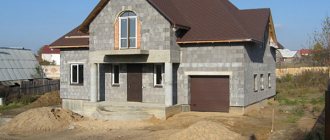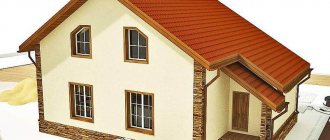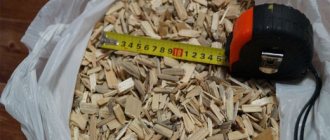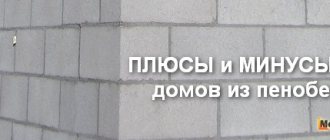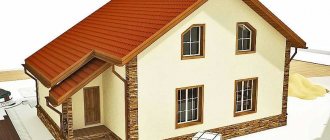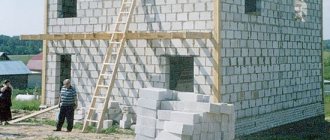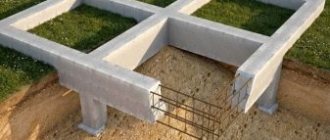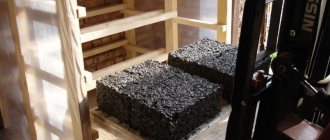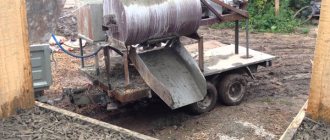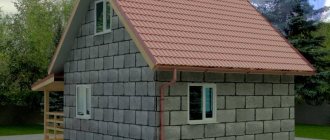Arbolite belongs to the class of lightweight concrete and has been widely used in the construction industry for more than 50 years. The advantages and disadvantages of this material are actively discussed. For complete information, you need to study the characteristics of wood concrete blocks and reviews of home owners about the disadvantages of their use.
Arbolit is lightweight concrete based on organic aggregates.
The main advantages of using wood concrete in construction
Wood concrete consists of wood chips with binder cement and chemical additives.
3 types of products are made from the material:
- slabs;
- blocks;
- monolith.
Arbolite blocks are divided into
- structural;
- thermal insulation.
Light weight
90% of wood concrete is wood processing waste.
The material is light: the weight of one standard size block is about 20 kg.
This provides:
- easy transportation;
- seismic resistance - the building’s resistance to earthquakes within the acceptable risk and the possibility of construction on any soil;
- easy adaptation of architectural designs of houses formed for other types of blocks (foam concrete, gas silicate, etc.)
- no need to make a complex, deep foundation and use additional lifting mechanisms when laying.
Easy to process
Wood concrete blocks and slabs are easy to process:
- sawing with a chainsaw and grinder;
- cut with a hacksaw;
- nail;
- screw in self-tapping screws without dowels.
Wood concrete blocks are easy to saw with a chainsaw.
Products can be easily adjusted to the required dimensions, technological openings can be cut and attachments can be attached.
Easy to build walls
One standard size block (30 cm thick, 25 cm high, 50 cm wide) replaces 15 to 19 bricks, so building a wall takes less time. It is easier for masons to work with this material, which also shortens the period of construction work. The masonry is made using a standard cement-sand mortar.
Good plastering
The texture of wood concrete products is porous, which allows the plaster to penetrate inside the block and be better fixed.
Arbolite blocks are well plastered.
If the blocks are not treated with machine oil, the solution will be fixed even without the use of an overhead mesh. The material requires plaster on both sides.
Wood concrete walls can be plastered using various building mixtures:
- cement;
- plaster;
- limestone.
Low thermal conductivity
Arbolite provides additional heat saving due to its porous structure. Its thermal conductivity is 0.07−0.17 W/(m*K). Houses made of this material heat up faster and retain heat longer.
Non-flammability
Arbolite is fire-resistant and resists burning for an average of about 3 hours.
The material has the following fire resistance coefficients:
- flame retardancy (G1);
- low flammability (B1);
- low smoke generation (D1).
The material is flame retardant.
The wood in the structure is impregnated with mineralizers and covered with cement.
Plastic
One of the advantages of wood concrete is its bending strength. A blow to the block will only leave a small dent.
Products made from this material can return to their original shape after deformation.
The blocks are easy to transport over long distances and install. When the building shrinks, they do not burst, but shrink without causing cracks in the walls or finishing. However, it is recommended to construct a monolithic armored belt to uniformly distribute the load over the entire area of the walls.
Breathability
Good vapor permeability of wood concrete provides residents of houses with a favorable microclimate without additional ventilation.
Air permeability ensures a favorable microclimate.
Cheap material
The cost of wood concrete is low because Most products are made from cheap raw materials (wood chips, crushed bark and pine needles).
When building a house, you can reduce costs by:
- construction of the foundation;
- insulation and wall finishing.
Disadvantages of wood concrete
Arbolite has a number of disadvantages.
High water absorption
The high level of water absorption is determined by the wood filler content in the wood concrete. Therefore, when constructing a building, additional protection is necessary:
- plaster;
- waterproofing walls and roofs.
It is not recommended to lay the building in wet weather.
High water absorption is due to the presence of wood filler in the wood concrete.
All these facts make it irrational to use the material in rooms with high humidity, as a base for a foundation, or for construction in regions with high amounts of precipitation.
Dangerous chemicals in the composition
Experts note that the addition of chemical additives (calcium chloride, sodium, soda, hydrochloric acid, liquid glass, magnesium sulfate, calcium nitrate, ammonium sulfate, copper sulfate) in the production of concrete reduces its environmental friendliness. The total amount of additional ingredients can reach 2-4% of the total weight of cement.
Weak frost resistance
Frost resistance of blocks is from 25 to 50 cycles. Such indicators with high water absorption (up to 80%) reduce the operational properties of the constructed building. You can increase the resistance of a room to frost by using insulation and wall cladding.
Arbolite blocks have poor frost resistance.
Lack of resistance to aggressive gases
Wood concrete products are poorly resistant to aggressive gases, which, in combination with other environmental factors, destroy the material.
Lack of strength
The strength of wood concrete depends on the production method. In the construction market, the M25 grade is considered the norm, which corresponds to a pressure of 25 kg per 1 cm³. If the product is made from low-quality cement, it will crack and crumble.
Unaesthetic material
The disadvantage of wood concrete blocks is their unaesthetic appearance. Buildings made of this material require facade finishing. Some manufacturers provide products with a ready-made facing layer.
Arbolite blocks are an unaesthetic material.
Poor quality finished blocks
There is a high risk of purchasing defective material with:
- deviations in size;
- incorrect proportions of ingredients;
- non-certified chemical additives.
Description and features
The composition of wood concrete includes:
- filler - wood chips, quite strictly limited in size, as well as crushed rice straw, flax seeds, cotton stems, and even pine needles and bark;
- binder – cement of the appropriate brand. This depends on the expected strength of the material, but not lower than M300;
- chemical additives - provide a better connection of components, rapid hardening, and so on. Mainly chloride salts of potassium, calcium, aluminum, as well as “liquid glass” are used.
Wood chips and cement are materials that are difficult to combine with each other, so it is very important to observe all the features of the production technology, in particular, thorough and long-term mixing of the initial mixture.
- The raw material is no less important: the size of the chips is important - no more than 25 mm in length and 10 in width, a certain degree of roughness, the type of wood - spruce, pine, beech, and even the nature of the wood - early or late. If all GOST standards are observed, the material turns out to be porous, “breathable”, but at the same time durable.
- The composition of the starting components affects the result to no less extent. For thermal insulation material, the ratio is usually as follows: 1 share of binder, 1 share of wood chips and 1.5 shares of water, or rather, a solution with salts. To obtain a structural material, the proportion of binder increases within certain limits.
- During production, it is not the proportions that are regulated, but the resulting properties of wood concrete. If they comply with GOST or TU, then the composition is considered suitable for use.
Reviews from home owners about wood concrete blocks
Konstantin, 37 years old, St. Petersburg: “The house doesn’t warm up. As the operation of the building has shown, it is impossible to do without additional insulation. The first reason for low frost resistance is the use of a structural block rather than a thermal insulation block. The second is the increased cement content in the raw material, which increases the thermal conductivity of the walls.”
Peter, 40 years old, Surgut: “The house made of wood concrete is warm. The material is blown through, this was fully evident at the stage of wall construction, immediately after the installation of windows and doors. After finishing the walls, the problem with drafts was eliminated. So, with the right design, the tendency to blow can be made an advantage of the building, since the necessary ventilation of the rooms is ensured. This was my first time working with the material, so I studied the video before starting construction.”
Vitaly, 50 years old, Orel: “Arbolite blocks have been used since the times of the Soviet Union. This is a warm, light and quite durable material. It is non-flammable and does not rot. Made from wood chips and cement, it is also environmentally friendly. It can be used to build private houses and non-residential premises (garages, sheds, warehouses). Wood concrete is plastered on the inside and outside, because is blown. Water passes through it, but this does not affect the properties of the material in any way.”
Deviations of geometric shapes
The main disadvantage of wood concrete is the inaccuracy of its geometric parameters (two, at first glance, identical wood concrete blocks can differ in size by up to 1.5 cm), which cannot be compared with the indicators of such lightweight concrete as sibit or foam concrete.
Due to this deviation, during the construction process it is necessary to increase the thickness of the seams, which sometimes reaches 30 mm. Under such conditions, so-called cold bridges are formed, resulting in freezing of the masonry at the seams. Of course, this does not have a strong impact on the speed of wall construction, however, in this case there is an overconsumption of building material.
In order to at least somehow level out the resulting unevenness during the laying of blocks, it is recommended to use more expensive warm perlite solutions.
Reviews from construction experts
Mikhail, 51 years old, Kaluga: “I am a foreman of a construction team. We had a chance to work with this material and observe how it behaves over time. Wood concrete is cheap and does not need to be insulated. But be sure to plaster from the outside. Easy to process with a chainsaw.”
Valery, 47 years old, Moscow: “Arbolite block is an environmentally friendly building material. A house built from these blocks breathes well and does not require constant impregnation. It is convenient and quick to build buildings from it. The material is practical. It's easy to work with. I took 2 types of blocks of different sizes for load-bearing walls and partitions. The raw materials are made from wood chips, cement and sulphate. Not subject to rotting, withstands 2 hours of open fire.”
Vladimir, 31 years old, Rostov-on-Don: “I am a specialist with more than 20 years of experience. Negative expert reviews are associated with the purchase of a low-quality and cheap product. Wood concrete is a specific material, and when working with it you need to know many subtleties.”
How to choose a wood concrete block
When purchasing, you need to pay attention to:
- Appearance. Typical color is grey. Shades of brown or green are a sign that the blocks were not fully dried or contain an excess of various additives (soil, straw, knots, etc.) that exceeds the norm.
- Size of chips and sawdust. Large dimensions indicate that the blocks are not saturated with mineralizers and are not protected from adverse environmental influences. The small diameter of the wood filler leads to damage to the reinforcing bonds and deterioration of the thermal insulation properties.
- Texture. Cracks, cavities, visible irregularities in geometry indicate the use of low-quality equipment, violation of production technology, and the use of raw materials of different sizes.
When purchasing wood concrete blocks, pay attention to the appearance and texture.
All blocks made from wood concrete are subject to mandatory certification.
Choice: everyone has their own
What are wood concrete blocks: are the disadvantages or advantages more serious? If everything is more or less clear with the first question, then the owners of the future home will have to think for themselves about the advisability of using this type of lightweight concrete. None of the existing building materials is perfect, so the choice largely depends on the weather in the region, on the desire to get by with less money, and on the owners’ idea of a durable, reliable, safe and comfortable building.
A close acquaintance with wood concrete will allow you to make a final decision. One of the educational videos will help you evaluate the “symbiosis” of concrete and wood:
conclusions
Frost resistance, moisture absorption, ventilation, etc. directly depend on the material from which the building is constructed. Without planning additional insulation, such houses are not recommended to be built in regions with low temperatures and high air humidity.
Building houses from wood concrete takes less time than, for example, from brick or aerated concrete blocks, because it is lightweight and easy to process.
Houses made of wood concrete can be built on any terrain and type of soil due to its plasticity and low shrinkage rate (0.4-0.8%).
Arbolite is suitable for low-rise construction. Premises ranging from 100 to 150 sq. m can be 1 or 2 floors and include an attic, a garage and even a basement or ground floor.
Wood concrete is a relatively inexpensive raw material. Costs may increase during transportation (not all regions have certified products), insulation, and sound insulation. The purchase of blocks with a violation of the surface geometry will also lead to an increase in construction costs.
Provided that the lower rows of blocks are properly waterproofed and normal ventilation is provided in the house, wood concrete does not rot, and mold does not appear even in rooms with high humidity levels. Thanks to vapor permeability, there is a natural exchange of air and moisture in the premises.
Popular manufacturers and average cost of production
Wood concrete, although lightweight, is still concrete, and therefore it is more profitable for the builder to contact the nearest manufacturer, if, of course, the quality of its products is really worth a good word. Very often, wood concrete is produced using a rather artisanal method, which significantly affects its properties and its reputation.
Most often, companies offering the construction of buildings from wood concrete produce it themselves
- - one of the largest manufacturers in Russia, produces more than 1000 cubic meters. The cost of finished blocks depends on the type of material: the price of thermal insulating wood concrete per piece is 4600 rubles. per cubic meter m, and structural - from 5400 to 6200 rubles. per cubic meter m.
- The wood concrete products plant offers blocks of various sizes. The average cost of products is from 3600 rubles. per cubic meter m.
- The construction and trade company produces solid and hollow wood concrete at a price of 5,250 rubles. per cubic meter. The price here also includes delivery of the material.
- The Velizh house-building company has been producing wood concrete blocks since 2007. The cost of products is from 3900 rubles. per cubic meter m.
- The Vologda wood concrete plant offers structural wood concrete for 4,200 rubles. per cubic meter m.
